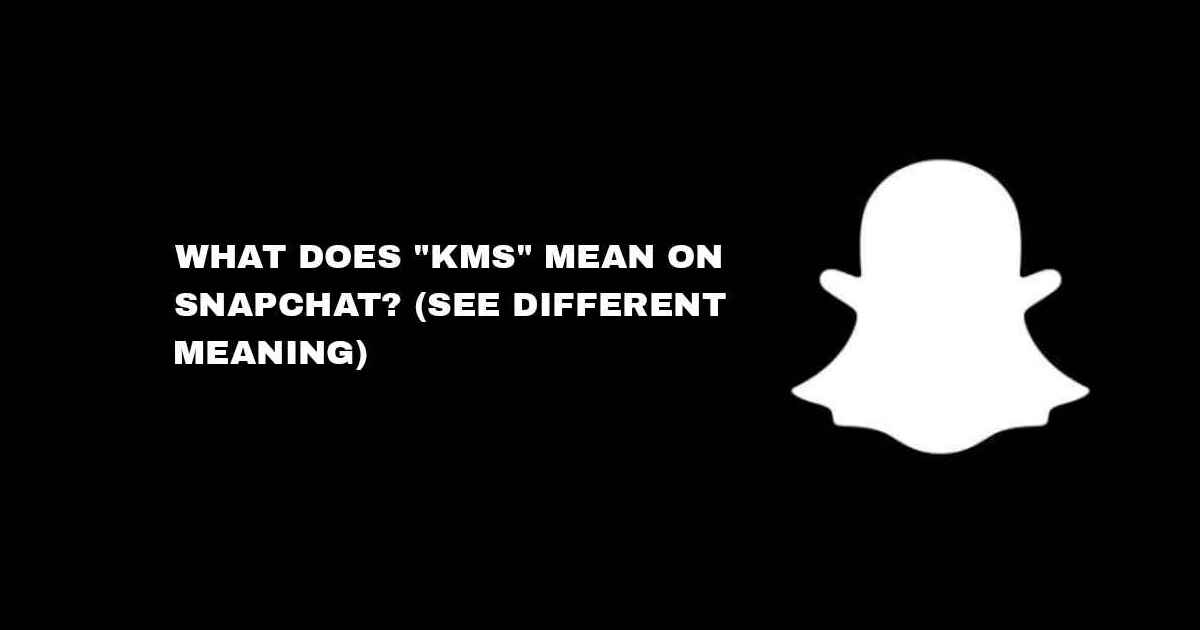What Does KMS Mean on Snapchat: Understanding Its Slang Meaning and Usage
In the ever-evolving landscape of social media and messaging platforms, new acronyms and phrases emerge regularly. One such abbreviation that has gained popularity on Snapchat is “KMS.” For those unfamiliar with this term, deciphering its meaning and context can be puzzling. In this article, we’ll delve into What Does KMS Mean On Snapchat and address some frequently asked questions surrounding it.

What Does KMS Mean on Snapchat:
KMS is an abbreviation for Kill Myself. It is commonly used as an expression of extreme frustration, despair, or exaggerated exasperation. When someone uses “KMS” on Snapchat, they are typically expressing a feeling of being overwhelmed, upset, or stressed to the point where they may jokingly or seriously express a desire to end their life. It’s important to note that while “KMS” is often used casually or as a form of dark humor among friends, it should never be taken lightly, as it may indicate underlying mental health issues.
Other Similar Terminology Used on Snapchat that You Should Know:
On Snapchat, similar terminology or acronyms are often used by users to express various sentiments or actions. Some examples include:
SFS – Shoutout for Shoutout:
A mutual promotion where users shout out each other’s Snapchat accounts.
WCW – Woman Crush Wednesday:
A hashtag used to show appreciation for a woman on Wednesdays.
MCM – Man Crush Monday:
Similar to WCW, but used to showcase admiration for a man on Mondays.
TBT – Throwback Thursday:
Sharing nostalgic or older content on Thursdays.
OOTD – Outfit of The Day:
Sharing a photo or video of one’s attire for the day.
BFF – Best Friends Forever:
Referring to close friends or companions.
FOMO – Fear of Missing Out:
Describes the anxiety or apprehension of missing out on social events or experiences.
TBH – to Be Honest:
Used to preface a candid or honest statement.
ROFL – Rolling on The Floor Laughing:
Indicating intense laughter.
HBD – Happy Birthday:
Wishing someone a happy birthday.
These are just a few examples, and Snapchat users continually come up with new acronyms or phrases to express themselves creatively on the platform.
FAQs About “KMS” on Snapchat:
Is It Okay to Use “KMS” as A Joke?
Using “KMS” as a joke may be common among some circles, but it’s essential to consider the sensitivity of the subject matter. Joking about suicide or self-harm can be hurtful to those who struggle with mental health issues or have been affected by suicide in their lives. It’s best to avoid using “KMS” casually and instead opt for more positive and supportive language.
What Should I Do if I See Someone Using “KMS” on Snapchat?
If you come across someone using “KMS” on Snapchat or any other platform, it’s essential to take it seriously. Reach out to the person privately and express your concern for their well-being. Encourage them to seek help from a trusted adult, friend, or mental health professional. If you believe the person is in immediate danger, do not hesitate to contact emergency services for assistance.
Are There Alternatives to Using “KMS” on Snapchat?
Instead of using “KMS” to express frustration or distress, consider using more constructive language to communicate your feelings. You can express your emotions openly with friends or seek support from a trusted individual. Additionally, engaging in self-care activities such as exercise, mindfulness, or creative expression can help alleviate stress and improve your mood.
How Can I Support Someone Who Is Struggling with Mental Health Issues on Snapchat?
If you notice that a friend or acquaintance is displaying signs of distress or mental health struggles on Snapchat, offer them your support and encouragement. Let them know that you are there for them and willing to listen without judgment. Encourage them to seek professional help if needed and provide them with resources or information about mental health services in their area.
Conclusion:
In conclusion, while “KMS” may seem like a harmless acronym used for casual communication on Snapchat, its underlying meaning carries significant weight. It’s essential to approach the topic of suicide and mental health with sensitivity and empathy, both online and offline. By promoting open dialogue and offering support to those in need, we can create a safer and more supportive environment for everyone.


